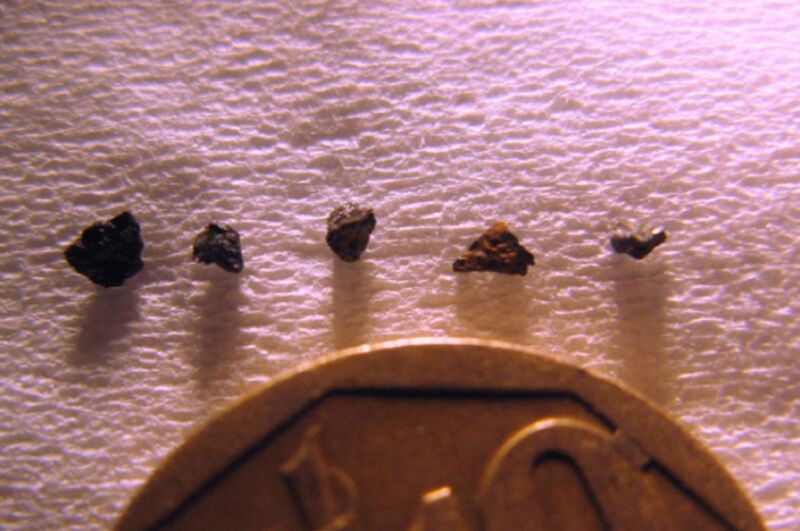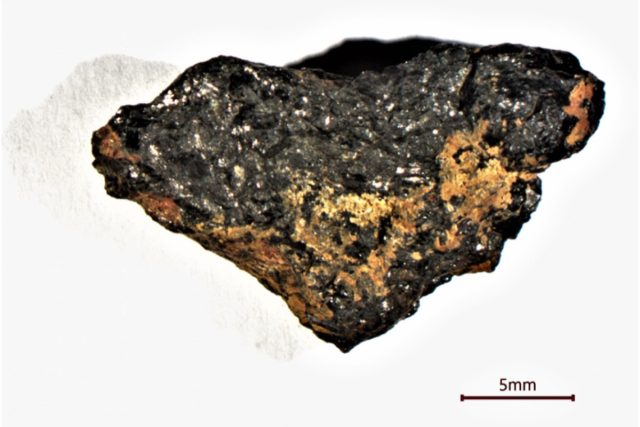
In 1996, an archaeologist named Aly A. Barakat was doing fieldwork in an Egyptian desert and stumbled across an unusual shiny black pebble now known as the Hypatia stone (after Hypatia of Alexandria). Studies conducted over the last several years indicate that the stone is of extraterrestrial origin. And according to a recent paper published in the journal Icarus, the stone's parent body was likely born in the aftermath of a rare type Ia supernova explosion.
The Hypatia stone was found in an area of southwest Egypt known for its Libyan Desert glass, produced by an extreme surface heating event, quite possibly a meteorite. The Hypatia stone may have also come from that impact, although more recent evidence suggests a comet would be a more likely parent body.
The University of Johannesburg's Jan Kramers and several colleagues have investigated the Hypatia stone for many years. Kramers compared the Hypatia stone's internal structure to a fruitcake: a poorly mixed dough forming the bulk of the pebble (mixed matrices), with the mineral grains lurking in the stone's inclusions representing the cherries and nuts. He likened the secondary substances in the stone's cracks to the flour dusting the gaps in a fruitcake.
In 2013 Kramers and colleagues published the results of a chemical analysis that provided strong evidence in favor of the stone being a comet fragment. This analysis was a striking suggestion since most comet fragments found on Earth are microscopic dust particles in the upper atmosphere or buried in Antarctic ice. The comet hypothesis would explain the presence of microscopic diamonds in the stone, likely formed in the impact when the comet exploded above Egypt some 28.5 million years ago. (The presence of those micro-diamonds is probably why the stone managed to make it to Earth without disintegrating)
However, work by other research teams in 2015 ruled out a comet or meteorite as the stone's source, based on noble gas and nuclear probe analyses. The mineral matrix just doesn't resemble the composition of known meteorites: For instance, it has a massive amount of carbon and a small amount of silicon. So if it didn't come from Earth, and it's not typical of a comet or meteorite fragment, where did it come from?

Kramers et al.'s 2018 micro-mineral analysis revealed that the matrix also has a high concentration of polyaromatic hydrocarbons (PAH)—a major component of interstellar dust—and those microscopic diamonds. The grains comprised of aluminum, silver iodine, phosphide, and silicon carbide, as well as a compound of nickel and phosphorus, with very little iron. The latter are elements that typically form the bulk of rocky planets. Based on this, Kramers and his colleagues suggested that the Hypatia stone contains matter that existed in space before our Solar System formed.
However, Kramers said at the time that it was unlikely the bulk of Hypatia's matrix formed before our Solar System because creating large bodies would require a dense dust cloud like a solar nebula. Only the nickel-phosphorus-iron grains probably formed in the pre-solar period, protected from the shock of a collision with the Earth's atmosphere and surface because they were embedded inside the matrix.
"What we do know is that Hypatia was formed in a cold environment, probably at temperatures below that of liquid nitrogen on Earth (-196 Celsius)," Kramers said in 2018. "In our Solar System it would have been way further out than the asteroid belt between Mars and Jupiter, where most meteorites come from. Comets come mainly from the Kuiper belt, beyond the orbit of Neptune and about 40 times as far away from the sun as we are. Some come from the Oort Cloud, even further out. We know very little about the chemical compositions of space objects out there."
That was the question Kramers et al. sought to answer with their latest study. Co-author Georgy Belyanin conducted a proton beam analysis of the stone in 2015, focusing on 17 target areas separate from the terrestrial minerals that formed in the cracks after they landed in the desert. This method enabled him to identify 15 different elements more precisely and accurately.
Kramers' analysis of the proton beam dataset enabled the team to rule out several competing hypotheses about where Hypatia may have formed. The data is inconsistent with any known type of comet or meteorite, inner solar system dust, typical interstellar dust, or a terrestrial origin. The scientists also considered the possibility of a red giant star, but the stone contains too much iron, too little silicon, and elements heavier than iron to make a red giant a viable candidate. That high iron component, plus the presence of nickel and phosphide, also rules out the more common Type II supernova.
That left the much rarer Type Ia supernova as the strongest candidate, events that generally occur once or twice each century in a given galaxy. These supernovas are the source of most of the iron in the universe, and such an event is the best match for the Hypatia stone's unusual chemical makeup. "In a sense we could say, we have 'caught' a supernova Ia explosion 'in the act' because the gas atoms from the explosion were caught in the surrounding dust cloud, which eventually formed Hypatia's parent body," said Kramers.
There's one caveat: It's not an exact match. For six of the 15 elements analyzed—aluminum, phosphorus, chlorine, potassium, copper, and zinc—the proportions were between 10 and 100 times higher than the ranges predicted by theoretical models. Kramers suggested that these elemental proportions may have been inherited from a red giant star.
If correct, this would make the Hypatia stone the first tangible evidence on Earth of a supernova type Ia explosion. "Perhaps equally important, it shows that an individual anomalous 'parcel' of dust from outer space could actually be incorporated in the solar nebula that our Solar System was formed from, without being fully mixed in," said Kramers. "This goes against the conventional view that dust which our Solar System was formed from, was thoroughly mixed."
DOI: Icarus, 2022. 10.1016/j.icarus.2022.115043 (About DOIs).
"type" - Google News
June 03, 2022 at 04:37AM
https://ift.tt/YkCFDv7
Mysterious Hypatia stone might hold earliest evidence of Type Ia supernova - Ars Technica
"type" - Google News
https://ift.tt/tUuyRLm
https://ift.tt/PkFdxHS
Bagikan Berita Ini














0 Response to "Mysterious Hypatia stone might hold earliest evidence of Type Ia supernova - Ars Technica"
Post a Comment